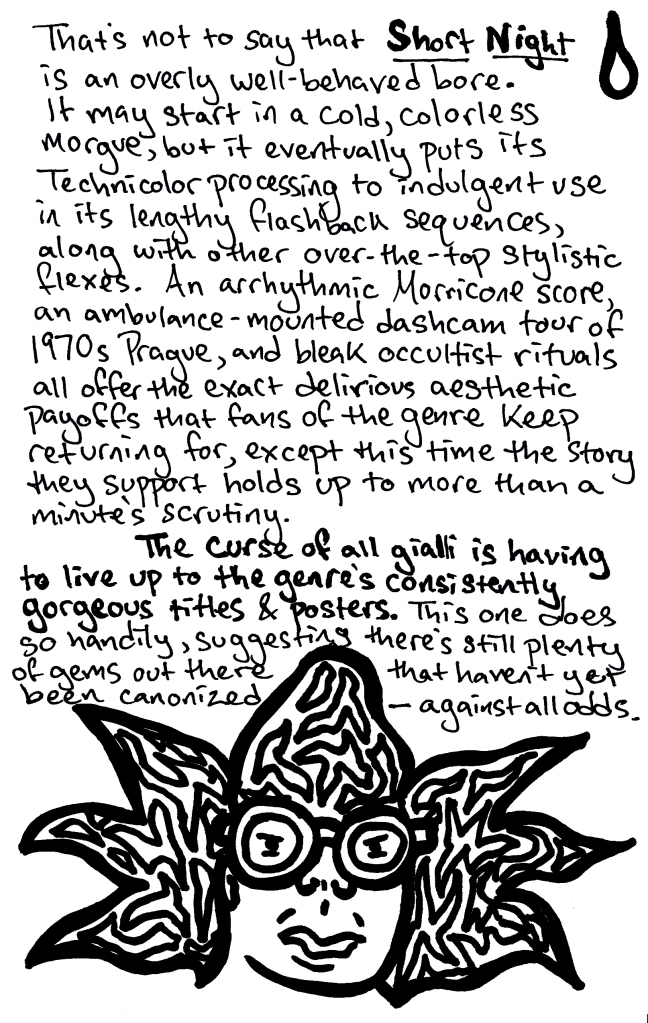Every month one of us makes the rest of the crew watch a movie they’ve never seen before and we discuss it afterwards. This month Hanna made Brandon, Boomer, and Britnee watch Lisa and the Devil (1973).
Hanna: I didn’t know anything about Mario Bava the first time I saw Lisa and the Devil (1974). It was two or three Halloweens ago, when streaming services pepper their suggestions with every horror movie in their arsenals, especially Argento & Bava films from the 70s with irresistible, colorful covers. The film has persistently clung to my mind since then because of its totally bizarre ending and its resplendent, House of Usher-esque mansion. I don’t know if it held up for me on a second viewing, and it has a gross depiction of sexual assault at ~1:14:00 that I had completely forgotten about, but I still overall enjoyed Bava’s spooky dreamscape.
At the outset of Lisa and the Devil, Lisa—a German tourist played by Elke Sommer—is climbing off a tour bus in Toledo, Spain. The very first stop of the tour brings her group to a mural of the Devil carrying the dead away, with a face that “expresses a quality which reflects the very soul of pleasure and evil.” Lisa seems struck by this mural, and inexplicably leaves her friend behind with the tour group to go wandering through the small Spanish village alone. She’s drawn into an antique shop and finds herself mesmerized by a sort of box-less music box/turntable with six rotating figures (if somebody could tell me what this thing is called, I would be much obliged – it’s extremely cool). She interrupts the shopkeeper’s conversation with the lone customer in the shop, who’s fussing over the particularities of a large wooden doll, to purchase the object. The customer turns to look at Lisa, who realizes that he bears a striking resemblance to the “very soul of pleasure and evil” plastered on the mural. From that point on, Lisa is lost; she dashes from the shop and wanders hopelessly through the deserted streets of Toledo, finding it impossible to return to the town square and repeatedly running into the menacing man from the mural (played by Telly Savalas) and the human manifestation of his life-size wooden doll. Eventually night falls, and she’s picked up by a tense couple and their driver in a lovely green car. Lisa is hopeful that this is the end of her nightmare, until the car breaks down in front of a sprawling Spanish villa of an elderly blind countess (Alida Valli) and her odd son Maximillian (Alessio Orano). The villa is staffed, of course, by Leandro, who continues to drag around his giant wooden doll for a mysterious purpose.
The rest of the film slowly unfolds into a visually striking festival of murder. The long shots of Lisa wandering throughout the remote village and the rich, green grounds of the villa are fantastic, and the interior of the villa oozes with a thick, decrepit opulence (I love the rotting cake room). I mostly found the performances a little lackluster, especially Sommer (who, despite being the leading lady, has about 10 lines of dialogue), but Telly Savalas is a pleasure to watch as a puckish devil butler who’s perpetually sucking on lollipops.
Britnee, I think I’m a Bava newbie compared to the rest of the Swampflix crew. I’ve heard some people say that this one is especially strange and dream-like, but it was the first Bava film I ever saw, so I didn’t have much of a reference for his body of work. How do you think Lisa and the Devil stacks up against his other films?
Britnee: I’ve actually only seen a couple of Bava films, but there was something different about this one. The other films I’m thinking of—Blood and Black Lace (my first Movie of the Month choice!) and Kill, Baby…Kill! in particular—weren’t as dreamlike for sure, but even more so, none had a character as comical as Leandro. Bava’s characters tend to be dark, mysterious, and serious – just not the type of characters that you really connect with. In no way is that a bad thing, because I’ve never watched a Bava movie for the cast. Bava movies are beautiful, bloody treasures about creepy sickos, and I expect nothing more. Leandro caught me off guard because I expected him to be terrifying since he’s basically the Devil. I thought he was going to terrorize Lisa from the moment she ran into him in the antique shop, but he felt like more of a guide instead – guiding Lisa and the audience to and around the castle while making clever comments and sucking on lollipops. He felt more like a witty uncle than Satan.
My absolute favorite thing about Lisa and the Devil are all of the creepy mannequins. The first one we see that continuously reappears is a mannequin of Carlos, the dead lover of the dead woman who Lisa resembles. But we eventually get introduced into a room filled with them! It seems that everyone who’s murdered by this bizarre castle family is transformed into a mannequin. This becomes apparent when Leandro takes Lisa’s measurements after she faints. I was hoping for some satanic ritual where Leandro turns the dead bodies into mannequins before our eyes, but it never goes down that road.
The ending of this film is so unexpected. Just when we think that Lisa is free and leaving Spain, she’s trapped on a plane with corpses and Leandro. This is where she turns into a mannequin and essentially dies. Brandon, what are your thoughts on the ending? Should Lisa have lived or died on the castle grounds instead?
Brandon: I don’t have any strong opinions about whether Lisa should have survived this film un-mannequined, but I do appreciate that she got to escape from the castle grounds after sunrise. At first, the shifting geography of the city and Lisa’s role as a silent observer had me thinking of this movie as a dream-logic story, but her return to the modern world outside the castle helped me re-contextualize everything as fairy tale logic, which is its own distinct thing. The way the castle feels untethered to the modernity, the way its decadent food is used as bait to lure in outsiders, and the way Bava constantly frames its inhabitants through mirror reflections all feel traditional to fairy-tale storytelling – something that didn’t dawn on me until the castle receded back into its own temporal limbo at, well, dawn. I loved seeing Lisa emerge from that fairy tale realm to return to her modern-tourist reality, and by then I was pretty much down for however Bava wanted to wrap it up. Maybe she couldn’t fully escape the castle because she ate the food and drank the wine: a classic fairy tale blunder.
As always with Bava, Lisa and the Devil is consistently beautiful, and parsing out the whats & whys of ~what’s really going on~ in its plot is miles beside the point. What I love most about this film is how much it resembles a standard haunted castle horror movie (maybe with more shapeshifting mannequins than usual) but the longer you grapple with its internal sense of logic the less familiar it feels. The car troubles that lead a foursome of naïve passersby to the film’s haunted castle are clichéd almost to the point of conscious parody, and yet the Technicolor surrealism they encounter inside is something you’ll be hard-pressed to find in any of the Hammer Horror or Corman-Poe movies it recalls. Boomer, what do you think Bava brings to the creepy-castle horror movie as a genre? Is his filmmaking or storytelling style particularly suited for this generically spooky setting in any way?
Boomer: One thing that I thought was notable here is that, when we think about Mario Bava, we mostly think about his earlier directorial work, starting with 1957’s I, Vampiri, then peaking in the early-to-mid 1960s. That’s the era with perennial classics like Black Sunday (1960) and Black Sabbath (1963) as well as movies that we’ve mentioned above: Blood and Black Lace (1964) and Kill, Baby, Kill (1966). After that, we get things like Hatchet for a Honeymoon (1970), which I did not care for, and 1972’s Baron Blood, which I got on VHS many years ago and managed to sit through precisely once. When we talk about Bava, we always talk about him as a horror or giallo director, and although that makes up the bulk of his filmography, we rarely talk about his sword-and-sandals swashbucklers (Hercules in the Haunted World, Erik the Conqueror), his non-giallo crime thrillers (like Danger: Diabolik), or his westerns (The Road to Fort Alamo, Roy Colt & Winchester Jack), and even his non-horror sci-fi The Day the Sky Exploded usually gets lumped in with his horror sci-fi like Planet of the Vampires and Caltiki – The Immortal Monster. But what’s really missing from this list are references to his comedy pictures, like spy spoof Dr. Goldfoot and the Girl Bombs and sex romp Four Times That Night.
Strangely, I think it’s the last of these that has the most influence on Lisa and the Devil, as it allows for a little levity in the proceedings. I don’t think any actor I’ve seen in a Bava film has been as magnetic and fun as Telly Savalas is here, hamming it up and clearly having a good time. The scene in which he bums a smoke from one of the visitors and then loudly chastises the man for smoking indoors when the blind countess enters the room is an inspired gag, as are his seemingly improvised moments, like when he dances with one of the mannequins. Italian horror movies are littered with scenes in which a person gives exposition to a bound or unconscious figure (Profundo rosso comes to mind), but Savalas manages to turn even this into a lively and comparably electric scene. I’ve often said that comedy and mystery “live” in the same mental space; what is a punchline if not a resolution that makes you laugh? What is the answer to a riddle if not the solution to a mystery? That Savalas is an American amidst these Europeans (most of whom probably learned their lines phonetically or were dubbed, both of which were in fashion at the time) also contributes to a separation between himself and makes him appear much more lifelike and composed. All too frequently, casting is treated as something that’s purely matter-of-fact in films; Dune is about the dangers of trusting a white savior and deconstructing that narrative of white messiahs, but that also means it’s about a white twink savior, so of course the current film adaptation has the whitest and twinkiest of currently working actors. Here, the casting of Savalas contributes to the tone, which I found fascinating.
To circle back on Bava’s storytelling style, the gothic is definitely where his powers reign supreme, and I don’t think that anyone else could have helmed this movie and captured that energy and atmosphere as well as he does here. Comparing this film to the body of work of his two major contemporaries, Dario Argento and Lucio Fulci, both of them made their own dreamlike haunted house stories within a few years, with Suspiria for the former and The Psychic for the latter, although the reasons for the house/school being/seeming haunted in each of those films is decidedly different, both from one another and from Lisa and the Devil. Lisa is also a much more successful counterposing of the modern and the gothic than the aforementioned Baron Blood. In that film, a modern (for 1972) American co-ed visits his ancestral home in Austria and resurrects a murderous aristocratic forefather, while Lisa is a modern (for 1974) tourist thrust into a decaying relic of a home inhabited by murderous aristocrats. That they both exist, were released a mere 2.5 years apart, and that Bava wrote both in addition to directing them, says something about his interest in contrasting those two things later in his life, and I do wish we could have seen more of that before he passed away in 1980. Interestingly, although Suspiria is largely considered Argento’s masterpiece and The Psychic was a film I heard discussed in certain circles with frequency, Lisa and the Devil is one I had never heard of before this viewing.
Shudder’s interface describes this as “Bava’s strangest film” (emphasis added), presumably because it boasts a more dreamlike atmosphere than his other horror fare, but I can’t say that I necessarily agree. Although the ending leaves much to the imagination and interpretation, this is a film that makes explicit early on that the narrative takes place in a timeless non-time on a carousel that loops. We first see the animated music box thing in the shop as soon as Lisa wanders away from her tour group, and it immediately captivates her, with the six figures depicted representing the characters that we will meet as well as the fact that, although they may be in motion and constantly moving away from one another, they are nonetheless in a closed loop that ends where it begins. We are also let in on the fact that the ghosts or spirits that reside in the villa are not necessarily bound there, as Lisa meets Carlos for the first time far from the Countess’s home; it’s here that he drops his watch, breaking it in such a way that the clock’s hands do not lie over its face, cluing us in that not only is this a loop, but one in which time has no meaning. Full size mannequins weren’t really a thing until the mid-1750s, when they were made of wicker. Wicker mannequins gave way to those made of wirework, which were supplanted with papier-mâché mannequins, which were themselves replaced with wax figures, which eventually gave way to the plastic mannequins—with which we are mostly familiar—in the 1920s. The figures here appear waxen to me, which immediately pegs them as being outmoded and out of time by half a century in the film’s contemporary 1970s setting.
Lagniappe
Hanna: Besides the gorgeous, lustrous cinematography, I will forever treasure Lisa and the Devil as the only film I know of with a haunted European villa and a haunted plane. I would 1000% watch Lisa descend further into madness in a surreal plane-centric sequel.
Britnee: I thought Leandro was strangely similar to the bald, lollipop sucking detective from the popular 70s detective show Kojak. Well, it turns out that they’re the same person. Telly Savalas is both Leandro and Kojak! Kojak premiered shortly after Lisa and the Devil, so this lollipop habit crossed over between the two as they were most likely being filmed at the same time.
Boomer: Telly Savalas is best remembered as TV’s Kojak or as one of many Blofelds (he’s the one in On Her Majesty’s Secret Service, for the record), but for me, he will forever be remembered as the stepfather from the Twilight Zone classic “Living Doll.” He’s also in The Alfred Hitchcock Hour‘s “A Matter of Murder” with Darren McGavin, meaning it’s the only time outside of their respective series that Kojak and Kolchak worked together, so stick that in your back pocket to whip out as trivia for your relatives at Thanksgiving this year.
If this film’s ending was a chiller to you, I also recommend the short story “Showdown,” by Shirley Jackson. Although spooky season as defined by the Gregorian calendar may be officially over, if you believe, you can carry it with you in your heart all year, and this short story, which was previously mentioned in our Lagniappe episode about 2020’s Shirley, remains one of the most chilling ghost stories to ever stir my soul.
Brandon: We cannot let this conversation go by without acknowledging the bizarre existence of 1975’s The House of Exorcism. Since contemporary distributors weren’t sure how to market Bava’s loopy nightmare in America as-is, they re-edited Lisa and the Devil into a cash-in knockoff of Friedkin’s wildly popular The Exorcist, titled The House of Exorcism. In that cut, the haunted castle sequences of Lisa and the Devil are recontextualized as hallucinations Lisa suffers while writhing in a hospital bed, possessed by Satan (there are also some additional nude scenes shoehorned in to up the titillation factor for the drive-in crowd). It’s a bizarre viewing experience if you’ve already seen Lisa and the Devil, simulating the horror of watching a shitty movie you remember being great – like revisiting the original King Kong only to find half the scenes replaced by clips from Bela Lugosi Meets a Brooklyn Gorilla.
Bava was rightfully appalled by the production of House of Exorcism, and successfully had his name removed from the project. It’s embarrassing as a standalone film, but I will say there’s a welcome novelty in seeing the horror master’s usual laidback pace properly sped-up in the edited-to-shreds clips it uses from Lisa and the Devil. It’s maybe the closest I’ve ever gotten to understanding disrespectful youngins who “speedwatch” everything at 1.5x.
Upcoming Movies of the Month
December: Brandon presents Lifeforce (1985)
January: The Top Films of 2021
-The Swampflix Crew














